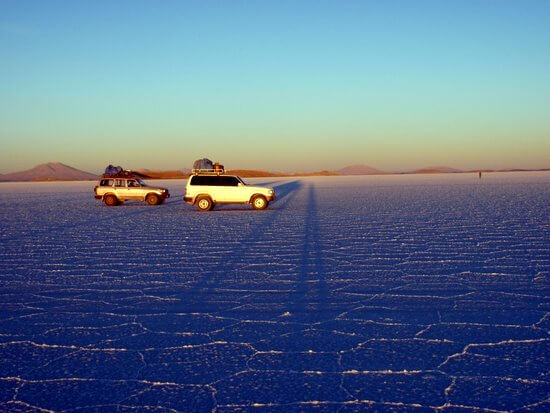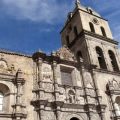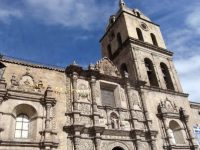Inspired by the 2009 Top Gear special we decided to go overland from San Pedro de Atacama in Chile to Uyuni in Bolivia, crossing the famous salt flats. The last group to try this a week ago were accosted by angry villagers and held for 12 hours under the threat of a good stoning. Two people died trying to drive through the blockade when their jeep overturned. Roadblocks and marches are common occurrences in Bolivia for the people to bring attention to their causes, but rarely turn violent.
We set off at 7.50 to the nearby border and exited Chile, then proceeded through no-mans land past Argentina and into Bolivia. The Bolivian border post was set atop a remote windswept hill and after immigration formalities, which weren’t very formal, we went outside to find the Bolivian 4x4s had arrived. I’d heard warnings of drunk drivers so picked the driver who looked too young to drink.
He introduced himself as Oscar and after we’d loaded our packs onto the roof he produced the ingredients for a cheese and ham sandwich breakfast. We then set off in his thankfully well maintained Toyota Land Cruiser.
There were no roads as such, just tyre marks from previous attempts, but he seemed to know where he was going, and not speaking a word of English didn’t bother to ask our opinion.
The scenic route to Uyuni takes in a number of natural landmarks. First up were four lakes; a white lake, coloured by Borax and Calcium; a green lake, reeking of sulphur and arsenic and a blue lake directly over a volcano, and the site of a hot springs where we could bathe.
Dropping down again slightly we drove across miles of open sand dunes, marked only by prehistoric lava spumes standing like soldiers in the desert.
Climbing back up to 4900m we summited another volcano and were treated to a field of geysers and steam vents shooting superheated water our of the ground in small but frequent bursts.
The next hour was spent driving through mud flats, bordered by deep red mountains until we arrived at our stop for the night, a simple Refugio built from breeze blocks and plastic sheeting. My bed was the pile of breeze blocks closest to the draughty front door.
Beside the Refugio lay a large red lake, coloured not by the iron in the mountains but by a red algae, which also made the local flamingos a brighter pink than most.
After a much needed spag bol dinner we realised there was no electricity, lights or hot water so went to bed at 7.30 for a very long and cold night. By the the altitude was getting to me, but an aspirin and a couple of hours sleep seemed to get me back to normal.
A 7am start saw us driving down into the driest part of the desert. Here there is zero moisture and therefore no life at all. Rapidly crossing the desert we came upon an outcrop of sandstone rocks. The one leading into the wind had been eroded into the shape of a stone tree.
Climbing up again to higher altitudes the temperature dropped rapidly and the next four lakes were all covered in ice.
One of the lakes was home to a local tribe who had tourism rights over the area and had opened a small cafe. I ordered a tea to go, and rather than the expected paper cup was surprised to receive a small teapot, china cup and a pot of warmed milk. When I reminded them I needed it to go they put it all on a tray and pointed at the table outside.
Sometime later we came to another lifeless moonscape, with a volcano spewing smoke in the background.
The Salt Flats
Our driver pulled out onto the smooth surface of the salt flats, turned off the lights and accelerated towards the centre. Normally this would be a little disconcerting but with 12,000 square kilometres of nothing to hit it was quite fun.
As the rising sun turned the mountains red, the skies pink and the salt a vivid blue, the extent of the salt flats was revealed and it was definitely worth a photo stop.
One outcrop in the salar is Fish Island, covered in coral and cactus, where all the drivers congregate for breakfast whilst the tourists clamber up and down the hills getting out of breath in the high altitude.
With the sun fully up we drove to a deserted spot and started taking photos. These can play perspective tricks due to the flat white surface.
Further on we reached the remnants of the last lake. The Salt Flats were formed by 11 lakes drying out on top of each other. It’s now 12000km square and 27m deep. At the lake it’s possible to reach through the crust into the water a few inches below and grab lithium crystals. Similar to Chile these are expected to become a major source of income for Bolivia when sold for use in rechargeable batteries, but when open cast mining starts it’s likely to be the end of the salt flats.
On the far edge of the plains is where the salt mining takes place. Salt is scraped up and dried in cones. This is also the location of the feeble salt museum and uncomfortably high salt hotel at 3600m.
Leaving the salt flat the ground turned to desert scrub again, and after passing through a military checkpoint we followed the abandoned rail tracks to a spectacular train graveyard. This is home to a number of rusting steam engines and carriages.
After being dropped off in the dusty little town of Uyuni (pronounced oo-joe-nee) we finally changed some money and went for a tasty pizza which gave us all food poisoning for the overnight 12 hour bus ride to La Paz.
Quick Warning…
Apparently laptop hard drives fail if you turn them on at an altitude of 3000m. I was at 5300m…
The drive across from San Pedro de Atacama was great – will be home on the 2nd if I manage to catch my rather short connecting flight (45mins to change at Newark), otherwise a few days later as I may as well stay in NY.









Pingback: Looking back through the travel archives #My7Links
Hi,
Enjoyed reading your informative piece. Thanks!
A few questions, as we contemplate a similar trip:
How did you get to the border from San Pedro de Atacama — by car, bus?
Did you have to carry a sleeping bag?
What was the charge for the jeep ride from the border, and how did you “negotiate” it?
Hi,
When you buy a 4×4 trip in San Pedro de Atacama it includes a short bus ride to the border, where you do the paperwork, then carry on to the 4×4 meeting point.
I did carry a sleeping bag, but they do give you a couple of thick duvets. I’d recommend taking at least a sheet as the beds were very dirty.
We bought the jeep ride at an agency in San Pedro and only managed to negotiate a small discount (5%) as there were 3 of us. Gather together a few more people and you may get a better price.
Have a great time!
Pingback: Jade Dragon Snow Mountain, near Lijiang | YNFAH
Hi Steve,
I have really enjoyed reading this piece.
I came across it while i was directly looking for stories of people such as yourself replicating Top Gears adventure.
I am currently a student at a design school in Bristol, UK, and i have been given a brief to create a double page spread for a magazine.
With the say so from you, i would like to use this piece to be the foundations for my design.
I would really like to here back from you.
Thank you in advance
Sure, what do you need? As long as it’s not for commercial use you can use whatever. A link back or mention would be appreciated.